Potosi, the world’s highest city (4,068 metres) holds a terrible secret…it’s citizens have made a pact with the devil and they are literally working themselves to death. Fathers, husbands and sons work in the Potosi mines endlessly enduring dangerous, appalling, medieval-like conditions all for a few precious metals they may be able to extract and sell for a small profit.
Potosi was founded in 1545 following the discovery of silver in the surrounding mountains by the Spanish conquistadors and by the end of the 1700’s Potosi had grown into the wealthiest city in the whole of Latin America. The price of wealth was paid in millions of deaths as African slaves and indigenous people were conscripted to work in hellish conditions. Today it is estimated that the mines have claimed in the region of 8 million lives but that doesn’t deter the thousands of people who still go to work down the mines each day. If the miners aren’t killed by explosions, collapsing tunnels or a runaway trolley, it’s likely that their lives will be cut short due to the silica dust or asbestos they’re breathing in each day. In fact, it’s thought that the majority of miners will die of silicosis pneumonia within 10 years of entering the mines.
So why on earth would anyone be crazy enough to take a tour into this dark, claustrophobic and frightening underworld? We asked ourselves the same question as we handed over 60 Bolivianos (9 USD) per person to the tour agent and reserved our visit to the mines for the following morning. We’d come to the conclusion that our South American adventure wasn’t solely about doing fun activities and enjoying beautiful places but it was also for discovering something about other people’s lives.
Our tour guide was a young man of 24 who’d experienced the hard toil of working in the mines first hand for a year before becoming a guide. He said that making the decision to leave the mines had been hard as he’d been earning around four times as much as the guiding pays but he truly hated the mining work and as an educated guy he was aware of the dangers the mine presented. We were amazed that miners often earn more in a month than doctors and teachers in Bolivia – around 2,000 Bolivianos (300 USD) so many people become sucked in – often supporting extended families who simply couldn’t survive without this income. We were also joined by a father and daughter from Germany who were holidaying in Bolivia and Peru following the daughter’s year-long study of Spanish in Northern Chile.
Our first stop was the miner’s market where we’d purchase some gifts for the miners we’d meet later. The types of items on offer were large bottles of fizzy drinks, cigarettes made from pure tobacco with no filters and 97 percent proof alcohol (no, that’s not a typo – and when we tried some, offered to us by our guide, we almost choked – it was like paint stripper!) Huge baskets of coca leaves were also for sale and our guide explained that the miners eat these leaves all day long, initially de-veining them, then chewing them into a ball and holding them in a pouch at the side of their mouth. The miners believe the coca leaves give them strength, stamina and reduces hunger whilst they work up to 12 hours per day and until they arrive home. The leaves are also meant to be good for relieving altitude sickness.
Everyone in our group took some leaves to sample – stripping the green leaf from its wiry stalk, we tentatively put them in our mouths. The leaves were not entirely unpleasant and had a bitter, almost medicinal plant-like taste. After a little while, the leaves made the insides of our mouths tingle and feel a little numb. We decided that the soggy ball of leaves probably wasn’t for us so we spat them out before entering the mines and before our mouths were the colour of iguanas!
We all bought plentiful supplies to take with us as gifts for a very small price. Even though our bags were filled with the most unhealthy of products we hoped that we would brighten up someones day. Our guide had one final surprise in store and took us to a shop where we could buy dynamite for the miners. Where else would we ever have this opportunity so in a matter of minutes, with no credential check, we were the proud owners of a block of dynamite, a short fuse and a detonator all for the sum of 25 Bolivianos (4 USD)!!
After the market, we were taken to a small store-room where we got changed into our overalls, Wellington boots and hard hats with battery-powered head lamps which would be turned on from the minute we entered the mines and kept on for the duration as there are no lights inside whatsoever! We all looked the part but inside our nerves were making our stomachs do somersaults.
We climbed back in the van and drove a further 400 metres to the top of Cerro Rico where we reached a cluster of buildings and an entrance shaft into the mines.
The views down to the city of Potosi were splendid but the mountain behind us looked ominous, dark and had an air of resentment that all of its precious minerals had been stolen from it.
Standing outside our guide offered us some history about the mines and we gulped down our last few breaths of fresh air. We learnt that the mines are not privately owned by one person or organisation but instead are worked by co-operatives employing groups of miners to labour in chosen sections of the mines and they split the profits equally, with a slightly higher cut going to the foreman. Up until just a few years ago, it wasn’t uncommon to find young boys of 14 and 15 years old working in the mines, however, today the legal age to enter the mines is 18 so fewer youngsters can be found. The miners are extremely superstitious people due to the nature of their work and all around the entrance to the mine, splattered on the walls and floors, was blood from sacrificial llamas intended to appease the wrath of the mountain and keep the miners safe from accidents.
Our safety briefing was short and to the point – the basic rules were to stick closely with the guide and do exactly what he told us to do. He impressed on us that this was a working mine and not a museum set up for tourists so situations could change in a matter of seconds potentially putting us in danger if we weren’t quick to react. And with those word of re-assurance ringing in our ears, we formed a line and walked single file into the mine shaft.
After just a few steps we were engulfed by complete darkness. The first 30 metres into the mine were freezing and thick layers of ice clung to the walls and as we walked deeper the temperature rose until we were sweltering. In some of the passageways we were able to walk with a straight back but for the most we walked hunched over, ducking and swerving to miss a multitude of pipes, broken wooden slats and bulging stone work which lined the ceiling and walls. The guide warned us not to touch any of the rocks around us, especially the ones which oozed with coloured liquid as the chemicals they omitted were especially toxic to the skin. So with our hands placed firmly by our sides we shuffled on.
Rectangular planks of wood wedged into the walls and roof helped to keep the rocks from caving in. Some looked very old and rotten and others had buckled under the weight above them. It didn’t fill us with much confidence. In some parts of the shaft the floor was covered in a layer of water and mud left over from recent heavy rain and this reached up to our ankles and made it difficult to walk, but other parts were much drier and scattered with dust and rubble. There was a metal track laid on the floor used by the trolleys which transport the precious stones out of the mines.
Every so often we would see a flash of light up ahead which was the signal that a trolley (frequently weighing up to half a tonne) was coming through and our guide would very quickly move us to a clearing by the side of the track to let the trolley, which doesn’t have any brakes, through. The air was thick and soupy and we took slow, deep breaths to fill our chests. We could see dust particles floating in the air and we felt them catching in the back of our throats. One of the pipes above us carried oxygen deep below us and offered some relief.
Even though the majority of the miners are Catholic in religion, here underground, they worship a devil called Tio and have created hundreds of statues of him of all different sizes and forms in the mines. Our guide took us to visit a larger than life version of Tio and a hush fell across the group when we came face-to-face with him. The body of a man with a giant penis and the face of the devil with red, twisted horns confronted us. He truly was a gruesome beast! Offerings of alcohol, cigarettes and coca leaves lay around Tio and in his open hands. There was also the foetus of a llama laying at his feet.
The miners believe that these offerings are a way to keep Tio happy and if they were to disrespect him, bad things would happen to them in the form of accidents or death. Even our guide still had a look of fearfulness about him as he talked to us about Tio and he placed some small gifts beside the statue before standing up and beckoning us to sit down beside him. We all had a picture taken with Tio and even though we’re not superstitious we couldn’t help smiling and nodding our heads in respect towards the clay built devil.
As we left the chamber housing Tio, the tunnel became narrow and the roof lowered. Before we realised what was happening we were crawling on our hands and knees across rubble and squeezing through incredibly small gaps. Neither Dan or I are claustrophobic but at that moment both of us felt our hearts beating out of our chests and our palms sweating with nerves.
Once the normal tunnel height had been resumed we twisted and turned a little deeper into a rabbit warren of passages until our guide announced we were now approximately 2 kilometres deep into the mines. We all took a deep breath as we realised how many tonnes of rock lay above us and how many more kilometres of tunnels still lay below us. The German girl had developed a headache and perhaps hadn’t quite realised what a trip to the mines entailed so asked whether she and her father could sit out the visit to the miners. The guide was OK with this but stressed that they must keep alert and keep to one side in case trolleys unexpectedly came through.
Dan and I followed the guide a few metres into a side tunnel where he asked us to wait whilst he checked where the miners were working that day. He was only gone for around a minute but as his footsteps disappeared and we waited in silence it felt like a very long time.
When the guide returned he had a cheeky smile on his face and he asked us “Are you ready to go Spiderman?” In for a penny, in for a pound we thought and we nodded at the guide with fake smiles. We soon discovered that going “Spiderman” meant lowering ourselves down an 8 metre hole in the ground with only the use of a rope (no safety harnesses here!) and crawling through a small shaft to where 6 miners worked side-by-side excavating a small cavern.
The temperature inside the cavern must have been around 40 degrees and we sweated uncomfortably. When we were first introduced to the miners we felt slightly voyeuristic and guilty that after our two-hour visit to this hell hole we could head back to the surface and continue our happy lives, however, the miners were very welcoming and happy to see us there.
The miners spoke no English and we had only limited Spanish but our guide translated questions and answers between us. They were intrigued to learn a little bit about us and where we came from and as always the universal language of football was a great conversation starter and each of them had an opinion of English football clubs. The miners were hugely appreciative of our gifts – gulping down the fizzy drinks we’d bought and ferociously devouring the coca leaves.
The miners bodies looked very strong but as we looked closer we noticed that their eyes were red, their skin was blemished, their teeth were rotten and their hands were calloused. All bar one of the miners were in their early 30’s and the other was early 40’s.
Each of them had worked in the mines for nearly 15 years and when we asked them how much longer they would give it they replied until they had enough money to retire. Miners earn good money but due to the nature of their work they often turn to hard drink, gambling and prostitutes for relief outside of the mines so their wages are often squandered.
We remembered the sad statistic that after just 10 years of working in the mines, health problems are common and we wondered how long some of these lads may have left. The group explained that they had always worked together in the mines and up until a year ago they were 7 people but a tragic accident caused by falling rocks after a dynamite detonation had put their friend in hospital for a long time and out of this type of work for good.
We took numerous pictures of the miners and they were fascinated to see themselves captured on-screen. They explained that they were digging for the metal zinc and when we asked them if this would earn them good money they simply shrugged their shoulders and said “more or less”. We shook each of the miners by the hand and sincerely thanked them for giving us a small insight into their way of life. We left their cavern feeling humbled by the determination or was it craziness of those men to earn a living in this way. We were truly thankful this wasn’t our existence and we knew that we would never moan about our jobs again.
The 8 metre climb out of the shaft using only the rope and walls to pull ourselves up took a lot longer than the way down with our arms straining and fingers clutching for hand holds. A couple of times our guide had to give me a humiliating push on my backside to help me up! Our bodies were shaking and exhausted by the time we reached the top and rejoined our friends. The German girl was feeling much better and they were amazed by the adventures we’d had without them. We headed out of the mines taking a shorter route to the exit.
The tunnels became lighter as we approached the outside world and we started to feel gusts of sweet, fresh air on our faces. We took big mouthfuls in like we were glugging water…and then…there we were, in the daylight, rubbing our eyes to adjust to the bright sunlight. We looked at each other and laughed as we were completely covered from head to toe in dirt and dust. Some miners standing close to the exit called us over and wanted photographs taken with the ladies in our group so of course we obliged.
We couldn’t say it had been an enjoyable experience as such, even though it had certainly got our adrenaline pumping and given us a small buzz. It had however, been a memorable experience which would make us reflect on our own lives for weeks and months to come. We had a new-found appreciation of how lucky we were to have choices in life, especially to be on a trip like ours, and we agreed that we’d no longer moan about the simple, petty annoyances in life that really don’t matter.


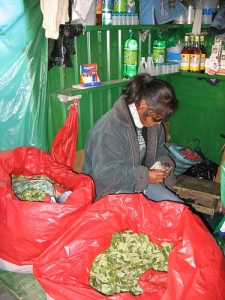

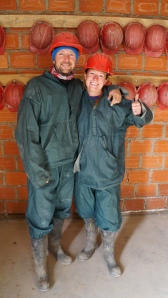

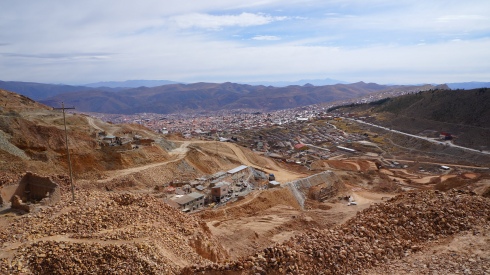

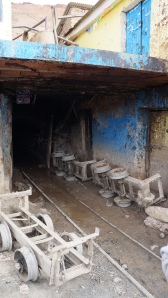

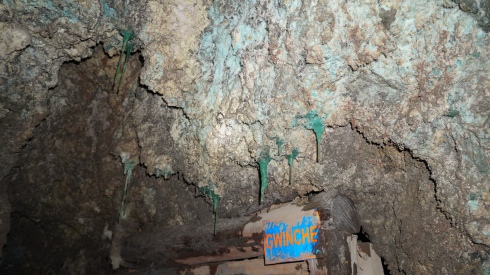
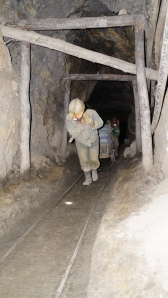
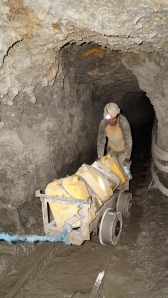

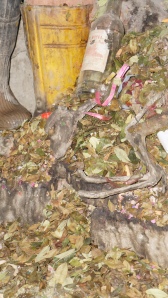






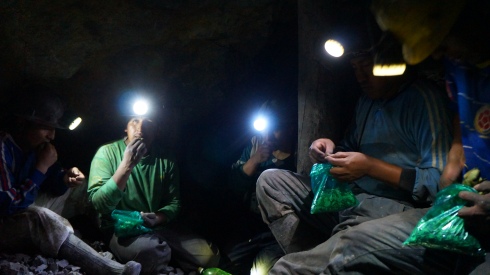



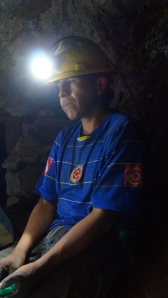
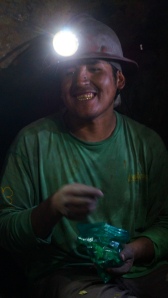



Hi Kate and Dan! Just been having a catch-up read of your blog – so many fab stories and adventures! Got to love the lack of ‘health and safety’ in Bolivia. The Potosi mines definitely help you appreciate a desk job! 😉 Lots of love and will send a proper email soon, Zoe xxx
Thanks Zoe! We loved the fact that anything seems to go in Bolivia – crazy but wonderful country! We’ll look forward to catching up with you soon xx
Hey Dan n Kate. Just looked at this site for the first time today and can see you two are having a proper holiday! Beats a fortnight in Butlins that’s for sure! Great writing and some top photies too. I’m very jealous and ready to hand my notice in tomorrow. Just hope you’ve got room in the tent! I see the miners are spending most of their money on hookers and booze. They probably wasted the rest then! Just don’t let Dan get any ideas! Have fun! Andy (Todd) x
Hey Andy! Thanks for your awesome comments. I will indeed keep Dan away from the hookers and make sure he shares the hard booze with me! Now we’ve got your hooked on the blog, make sure you stay tuned for the next installment. PS: Always lots of room for a little one in our tent – we hope your resignation is on your boss’ desk! Lots of love xx